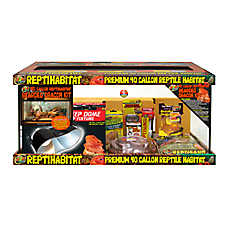How to Handle a Bearded Dragon: Do’s and Don’ts

In this Article
Bearded dragons are gentle, beautiful pets that bring so much happiness into homes. They deserve to live pampered, happy lives, from having the best habitat setup to having their parents know how to handle them the right way. Make sure to follow these do’s and don’ts for how to handle a bearded dragon.
Size:
Don’t - Make sure not to handle your bearded dragon until they’re the right size. These pets start out small and grow into sturdy, beautiful dragons. As babies, they’re vulnerable and easy to harm unless you’re an expert.
Do - Give your pet time to grow. Once they’re a couple of months old and at least 6 inches long, then it’s ok to start introducing them to the handling process.
Lifting:
Don’t - Grab them around their tummy and pull them swiftly out of their habitat.
Do - Be as gentle as possible with your bearded dragon. Slowly reach your hand in their terrarium and lift up on their chin. This will usually prompt them to start climbing onto your hand/arm. If they don’t climb, you can slowly place your hands around them and place them on your hand.
Support:
Don’t - Bearded dragons are sturdy and need their body weight to be supported. They’re not able to land on all fours like a cat would be able to. If they fall outside of their habitat, it could be very dangerous.
Do - Support their entire body weight using your hand and arm underneath them. This will give them a firm and stable surface to stay put on. If they’re going to explore a bit, watch them closely so they don’t get onto surfaces that could be unstable.
Environment:
Don’t - While bearded dragons are relatively docile; they can still experience stress. You never want to overstimulate your pet by handing them off to too many different people or getting them out of their habitat in a particularly busy or loud environment.
Do - Be sure to create a calm environment for your bearded dragon. Turn off the TV or other devices, and limit the number of people who are around.
Mealtime:
Don’t - Make sure to never bring your beardie out of their habitat right after a good helping of reptile food. This can make them extremely uncomfortable or even sick.
Do - Wait a few hours after mealtime, giving their meal plenty of time to digest.
Personal Space:
Don’t - Keep your bearded dragon out of their habitat for too long. They don’t necessarily enjoy being handled, even if they like you. You have to remember; people aren’t just picking them up in the wild. They might not be upset, but they would most likely prefer to go back into their habitat.
Do - The best amount of time to handle a bearded dragon is to limit the time outside of their habitat to 10-minute increments and leave plenty of time in between handlings. This might not always be possible should they need to go to the vet or something similar.
Body Temperature:
Don’t - Another important reason not to leave your bearded dragon outside of their habitat for super long periods of time is that it can mess with their body temperature.
Do - Your bearded dragon uses the basking spot and cool area of their terrarium to regulate their body temperature along with their habitat humidity. The more time they spend in their home, the better.
Hygiene:
Don’t - Handle your bearded dragon, put them back in their habitat and go about your day. As cute as they’re, any pet can transmit unwanted bacteria to their parents.
Do - Wash your hands every time you handle your bearded dragon or interact with their habitat/clean their reptile substrate.
Other Pets:
Don’t - Make sure to never handle your bearded dragon around other pets in the home. You never know how your pet might react to seeing your bearded dragon. Even if you’re positive that your other pet would not harm you, that does not mean it will not increase the stress your dragon is feeling.
Do - Shut other pets out of the room when you’re going to handle your reptile. This way, your dragon does not feel threatened or stressed.
Information in this article isn't intended to diagnose, treat or cure your pet and isn't a substitute for veterinary care provided by a licensed veterinarian. For any medical or health-related advice concerning the care and treatment of your pet, contact your veterinarian.


